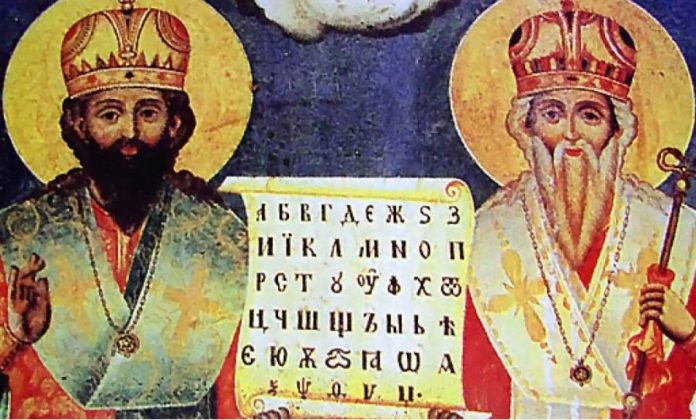The Thessalonian brothers are diplomats, missionaries, creators of the Glagolitic and Cyrillic alphabets
On May 24 every year almost the whole Slavic world celebrates the patrons of Europe, the creators of the Glagolitic and Cyrillic alphabets. Their lives passed in the development and spread of Christianity through sermons in Great Moravia and Pannonia.
1. They grew up in the family of the Byzantine military leader Leon and his wife Maria
Methodius was born in 815 and was their eldest son, and Constantine was the youngest of seven brothers and was born in 827. They are part of the Byzantine aristocracy, but both speak Slavic.
2. Methodius became archon – governor of an area inhabited by Slavs
The younger brother looked at the scriptures and at the age of 15 went to study at the Magnaur School of the Imperial Palace, where he later became a teacher and earned the nickname “Philosopher”.
3. The warrior Methodius was the first to retire to a monastery
According to some sources, this is because his wife and children die too early. Cyril entered medieval diplomacy when he was only 24 years old, when he went on his first mission to an Arab caliph, but then joined his brother in the monastery.
4. Creating the Glagolitic alphabet
Around 855, the two brothers began their work on the preparation of the Slavic script and created the first translations from Greek into Slavic. The Cyrillic alphabet was created on the basis of the Glagolitic alphabet and is still used today in many Slavic languages.
5. The discovery of the relics of St. Clement
In 860, Cyril and Methodius were sent by Emperor Michael III to the Khazar Hagan to prevent the spread of Judaism. This mission is associated with an extraordinary event, the unveiling of the relics of St. Clement.
6. The Moravian mission to Prince Rostislav
Prince Rostislav wants the church to become Slavic by creating a worship service based on the Slavic script. He suggests that Cyril and Methodius take on this task. The two brothers accepted the mission and enthusiastically began to build the Slavic church and school.
7. St. Cyril against the trilingual dogma
Brothers Cyril and Methodius received accusations from the German clergy that they did not obey church laws. The two missionary brothers make a brilliant defense. It takes place in Venice, where Cyril speaks against the trilingual dogma. “Doesn’t God rain equally for everyone? Doesn’t the sun shine on everyone too? Don’t we all breathe the same air? How are you not ashamed to define only three languages, but want all other tribes and peoples to be blind and deaf? ”(From“ Life and deeds of our blessed teacher Constantine the Philosopher)
8. Pope Adrian invites Cyril and Methodius to Rome
The Pope insists on talking to Cyril and Methodius about their work. The relics of St. Clement discovered by Cyril in the city of Kherson became a strong asset of the two brothers. They took the relics to Rome in the hope of receiving blessings and recognition for their alphabet and new books. The reception of the two brothers in Rome was solemn and full of honors.
9. The Thessalonian brethren were canonized as saints
Due to the translation of the Bible into Old Bulgarian and the spread of the Christian religion among the Slavic-speaking peoples, the two brothers were canonized as saints.
10. In 1980, Pope John Paul II declared the brothers co-patrons of Europe
Cyril and Methodius are revered by the Orthodox Church as one of the Holy Septuagint, along with their disciples – Nahum, Clement, Angelarius, Sava and Gorazd.
The revival of the homage in Rome to St. Cyril and Methodius in the new history of Bulgaria began in the first half of the 19th century and was associated with initiatives by both Orthodox and Roman Catholics.
In the 19th century, the work of the Holy Brothers in Rome was rediscovered in connection with the organization of celebrations on the occasion of the millennium of their mission among the Slavs. Pope Pius IX received a request from the Croatian Bishop Josip Strossmayer, a great friend of the Bulgarian people, to begin a study to discover the relics of St. Cyril. The pope welcomed the proposal and authorized archeological excavations at the Basilica of San Clemente by the famous archaeologist De Rossi.
Its work was continued by the archaeologist Maruli, who in 1862 found the supposed site of the tomb of St. Constantine-Cyril and discovered the unique early Christian frescoes depicting the transfer of the relics of St. Clement by Slavic educators in the presence of Pope Andrian and the entire clergy. and the people of Rome, as evidenced by medieval written sources. At that stage the relics of St. Cyril have not been discovered yet.
On September 30, 1880, Pope Leo XIII published the encyclical “Grande munus”, which commemorates the merits of the Holy Brethren for the evangelization of Europe and determines the liturgical celebration of their memory in the Roman Catholic Church on July 7. In 1881, on the initiative of Ep. Strossmayer in Rome is the first celebration of St. Cyril and Methodius. More than 1,400 pilgrims visit the Basilica of San Clemente to worship St. Cyril. Among them is a small delegation of Bulgarian Uniates, led by an archbishop. Neil Izvorov.
In 1885, a new chapel was opened in the Basilica of San Clemente, dedicated to the Holy Brothers, painted by the artist Nobili. The first documented official celebration by the Bulgarians on May 24 in Rome was in 1924. The idea came from Prof. Lubomir Miletic, President of the Bulgarian Academy of Sciences and lecturer at Sofia University, who also established the Committee for Settling the Celebration of the Bulgarian National Holiday of St. Cyril. and Methodius in Rome. ” Then a liturgy was celebrated by Archim. Simeon, representative of the Moscow Patriarchate in Rome. The holiday was celebrated very solemnly with a state reception at the Majestic Hotel.
In July and October 1925, the Roman Catholic Church in Bulgaria organized a pilgrimage to the Italian capital and the Basilica of San Clemente, related to the jubilee year. The leader of the trip is the newly appointed apostolic visitor in Bulgaria, Archbishop. Angelo Roncali, the future Pope John XIII. On October 12, Archbishop. Roncali performed a liturgy at the tomb of St. Cyril and delivered a speech on the merits of the Holy Brothers for Bulgaria and the Slavic world. Then Ferdinand Tomic described in the Roman Catholic newspaper Istina (issue 27, November 4, 1925) the miserable condition of the tomb of St. Cyril the Philosopher and called on the Bulgarian public to take care of the development of this “sacred place for Bulgarians in Rome.”












